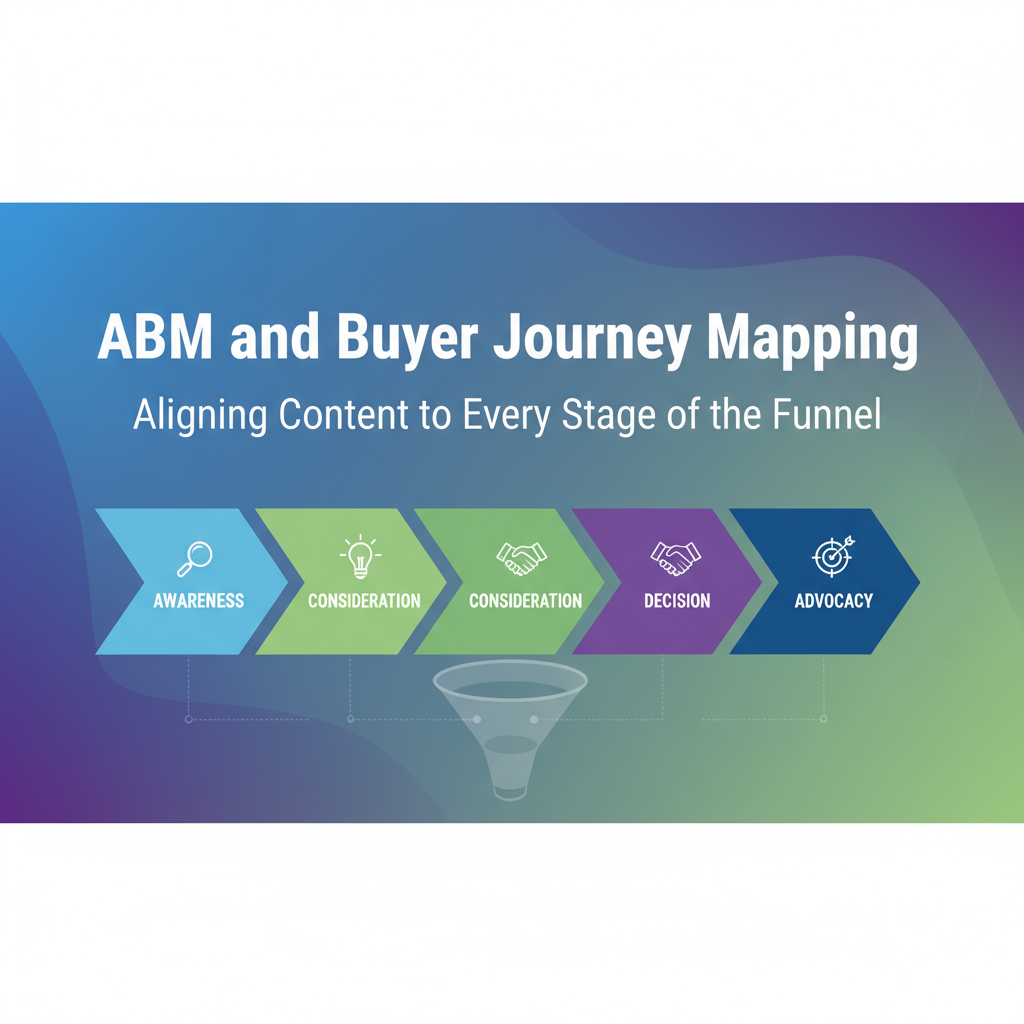Introduction
In today’s complex B2B landscape, success is no longer about casting a wide net—it’s about precision. That’s why Account-Based Marketing (ABM) has become the go-to strategy for B2B enterprises targeting high-value accounts. But even the best ABM programs can fall flat without aligning to one critical factor: the buyer journey.
Why does this matter? Because every decision-maker within a target account is at a different stage of awareness and intent. Delivering the same content to all won’t resonate. Instead, mapping ABM strategies to the buyer journey ensures your messaging meets prospects exactly where they are—building trust, accelerating sales cycles, and boosting conversions.
In this blog, we’ll explore the importance of buyer journey mapping in ABM, challenges marketing leaders face, actionable strategies to align content, and what the future looks like in 2025.
What is Buyer Journey Mapping in ABM and Why It Matters
Buyer journey mapping involves visualizing the stages prospects go through—from awareness to decision—and aligning your ABM campaigns accordingly.
In ABM, this process is critical because:
- Multiple stakeholders are involved in B2B deals. (IDC reports that an average of 6–10 decision-makers influence purchases in enterprise accounts.)
- Each stage requires different messaging. For instance, a CMO in the awareness stage may want to understand industry trends, while a procurement head in the decision stage wants proof of ROI.
- Without alignment, ABM campaigns risk wasted spend and lost opportunities.
Simply put: ABM without journey mapping is like running a marathon without a route map—you’ll exhaust resources without reaching the finish line.
Challenges in Buyer Journey Mapping for ABM Leaders
- Data Silos Across Teams
- Marketing, sales, and customer success often track buyer behavior separately, creating fragmented insights.
- Complex Decision-Making Units (DMUs)
- Each stakeholder may be at a different stage of the journey, requiring nuanced content strategies.
- Content Overload, Low Relevance
- Many ABM campaigns overwhelm prospects with generic assets rather than stage-specific value.
- Measurement Gaps
- Without clear journey-based KPIs, marketers struggle to connect ABM engagement to pipeline impact.
Example: A SaaS vendor pushed product demo invites to accounts still in the awareness stage, leading to low engagement and wasted budget.
Proven Strategies to Align ABM with the Buyer Journey
1. Map Decision-Makers by Stage
- Identify all stakeholders in your target accounts.
- Classify them into awareness, consideration, and decision stages.
- Use intent data and behavioral analytics to update journeys in real time.
2. Align Content Types with Each Stage
Awareness Stage
- Focus: Problem discovery, thought leadership.
- Content: Blogs, infographics, industry research reports.
- Example: “The Future of AI in B2B Marketing: Trends for 2025.”
Consideration Stage
- Focus: Solution exploration, comparisons.
- Content: Webinars, case studies, whitepapers, ROI calculators.
- Example: A healthcare IT buyer evaluating ABM platforms reads a case study on improved patient engagement.
Decision Stage
- Focus: Vendor evaluation, ROI proof.
- Content: Product demos, pricing guides, peer reviews, executive briefings.
- Example: A CFO receives a personalized ROI breakdown showing cost savings and time-to-value.
3. Personalize by Role & Stage
A CIO in the consideration stage values technical whitepapers, while a CMO in the same stage prefers customer success stories. Personalize both by buyer role and funnel stage.
4. Leverage Multi-Channel Orchestration
- Use LinkedIn ads, personalized email nurture, direct mail, and executive roundtables.
- Keep messaging consistent across touchpoints, tailored to the stage.
5. Enable Sales with Journey Insights
Provide sales teams with stage-specific talking points and assets to ensure seamless follow-ups.
Trends and the Future of Buyer Journey Mapping in ABM (2025 and Beyond)
- AI-Powered Journey Prediction
- AI tools will predict where each buyer is in their journey and recommend next-best actions.
- Dynamic Personalization Engines
- Content will adapt in real time based on buyer engagement patterns.
- Deeper Sales-Marketing Alignment
- Revenue teams will increasingly share journey maps through integrated RevOps platforms.
- Journey-Based Measurement
- KPIs will shift from generic MQLs to metrics like “account progression rate” across stages.
- Buyer Intent + Journey Fusion
- The integration of third-party intent signals with internal engagement data will give a 360° view of journey stages.
Pro Tips & Bonus Insights
- Start with 3–4 personas per account to keep journey mapping manageable.
- Use visual dashboards (e.g., HubSpot Journey Analytics, Demandbase) to track account progression.
- Align KPIs with stages: content engagement for awareness, demo requests for consideration, closed deals for decision.
Conclusion
In 2025, ABM is no longer just about targeting the right accounts—it’s about engaging them at the right time with the right message. By mapping the buyer journey and aligning stage-specific content, B2B brands can reduce friction, accelerate sales cycles, and increase win rates.
The future of ABM lies in precision and personalization, and journey mapping is the roadmap to get there.
